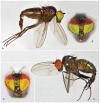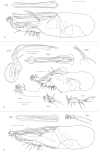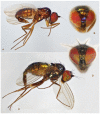Discovery of a Lineage of Soil-Dwelling Medetera Species with Multi-Coloured Eyes in Southern Europe (Diptera: Dolichopodidae)
- PMID: 36354836
- PMCID: PMC9699082
- DOI: 10.3390/insects13111012
Discovery of a Lineage of Soil-Dwelling Medetera Species with Multi-Coloured Eyes in Southern Europe (Diptera: Dolichopodidae)
Abstract
Seven species in the genus Medetera (Diptera: Dolichopodidae) are described here: Medetera aglaops sp. nov., Medetera corsicana sp. nov., Medetera gibbosipyga sp. nov., Medetera hispanica sp. nov., Medetera lusitana sp. nov., Medetera parva sp. nov., and Medetera rectipyga sp. nov. They all originate from the wider Mediterranean region in southwestern Europe (Iberian Peninsula, southern France, Corsica, Sardinia). The most striking feature in most of the species is the bi- or multicolour pattern of the eyes, most conspicuous in Medetera aglaops sp. nov. and Medetera lusitana sp. nov. This character is shared by the male and female sex and is thus not regarded as Male Secondary Sexual Character. All species belong to the Medetera apicalis species group sensu Bickel and are closely related based on shared characters in the hypandrium and cercus. Interestingly, three species with and four species without the basal pair of anterodorsal and posterodorsal bristles on the mid tibia are represented. This suggests that this diagnostic character has less phylogenetic relevance than previously anticipated. Unlike most Palaearctic Medetera, at least five of the new species are mostly found on rocky substrates in dry biotopes with a sclerophyllous vegetation. This further supports their relationship with species of the Medetera muralis subclade sensu Pollet, Germann and Bernasconi.
Keywords: Corsica; Iberian Peninsula; Mediterranean region; Sardinia; ecology; eye pattern; phylogeny.
Conflict of interest statement
The authors declare no conflict of interest. The funders had no content-related role in any phase of this study.
Figures












References
-
- Yang D., Zhu Y., Wang M., Zhang L. World Catalog of Dolichopodidae (Insecta: Diptera) China Agricultural University Press; Beijing, China: 2006. pp. 1–704.
-
- Negrobov O.P., Naglis S. Palaearctic species of the genus Medetera (Diptera: Dolichopodidae) Zoosystematica Ross. 2016;25:333–379. doi: 10.31610/zsr/2016.25.2.333. - DOI
-
- Naglis S., Negrobov O.P. New species and new records of Medetera (Diptera, Dolichopodidae) from Switzerland. Mitt. Schweiz. entomol. Ges. 2014;87:229–245.
-
- Naglis S., Negrobov O.P. Palaearctic species of the Medetera betulae group (Diptera, Dolichopodidae), with the description of three new species from Switzerland. Mitt. Schweiz. entomol. Ges. 2014;87:85–93.
Grants and funding
LinkOut - more resources
Full Text Sources
Medical

